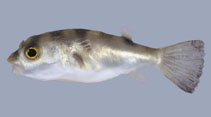| Family: |
Tetraodontidae (Puffers), subfamily: Tetraodontinae |
| Max. size: |
29.3 cm TL (male/unsexed) |
| Environment: |
demersal; freshwater; brackish; marine; pH range: 7; dH range: 10; depth range 1 - 40 m |
| Distribution: |
Western Atlantic: Gulf of Paria to the Amazon River in Brazil. |
| Diagnosis: |
Dorsal spines (total): 0-0; Dorsal soft rays (total): 11-12; Anal spines: 0-0; Anal soft rays: 11-11. Body except for snout, pectoral base and caudal peduncle covered with prickles; teeth fused into plates, two plates on each jaw; nostril with two openings; body dark green dorsally with six transverse black bars, white ventrally; fins dusky green or dark brown (Ref. 13608). |
| Biology: |
Solitary or in groups of 2 or 3 individuals but never in schools (Ref. 35237). Inhabits shallow inshore waters usually on soft bottoms. Frequently found in freshwater (Ref. 13608). When threatened, it becomes inflated like a balloon, in order to ward off predators. Carnivorous, feeding mainly on mollusks which crushes with its powerful teeth (Ref. 35237). Of negligible commercial importance and usually not marketed (Ref. 5217). |
| IUCN Red List Status: |
Least Concern (LC); Date assessed: 07 June 2011 Ref. (130435)
|
| Threat to humans: |
harmless |
Source and more info: www.fishbase.org. For personal, classroom, and other internal use only. Not for publication.

